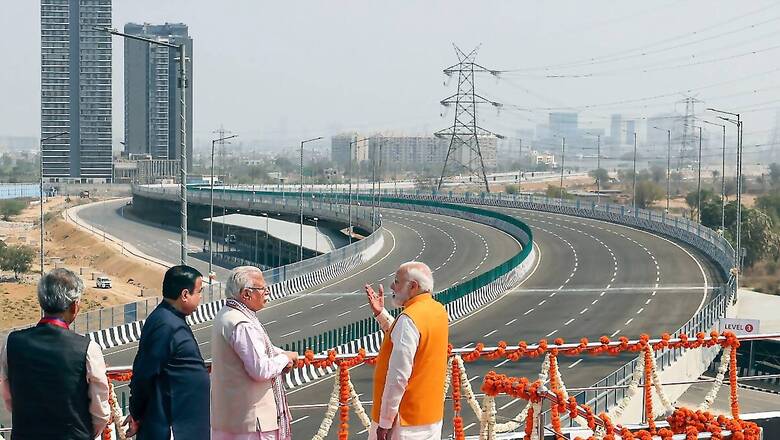
views
So far, in this multipart series, I have analysed the 10-year performance of Prime Minister Narendra Modi’s government in Rail and Metro Rail sectors. In this part, I create a balance scorecard of the past 10 years’ developments in roads and highways, a sector that has been at the forefront of the Prime Minister’s push towards creating fast-paced infrastructure.
75-Day Odyssey
In the first 75 days of 2024, before the Election Commission announced the schedule for Lok Sabha elections, Prime Minister Modi inaugurated infrastructure projects across the country worth Rs 10 lakh crore. A quick analysis of the completed projects dedicated to the nation and new projects for which the foundation stones were laid indicates that major share in both the categories belonged to projects pertaining to roads and highways sector.
All in a Day
It is worth noting in this context that on March 11, the Prime Minister dedicated to nation completed projects and laid the foundation of 112 national highway projects worth more than Rs 1 lakh crore in 11 states – Bihar, West Bengal, Maharashtra, Rajasthan, Uttar Pradesh, Punjab, Himachal Pradesh, Haryana, Karnataka, Kerala and Andhra Pradesh. Among the projects inaugurated is the iconic Haryana section of the eight-lane Dwarka Expressway.
Unprecedented
Indubitably, the spate of inaugurations of completed projects and laying of the foundation stones of new projects on the election announcement eve must be seen as a tool to sway the mood of the voters across the country towards the ruling dispensation. Nonetheless, in the sheer scale, speed and enormity, the construction, completion, inauguration and announcement of new projects across infrastructure sectors in general and roads, highways, expressways, and bridges appears unprecedented in nature.
This is the canvas against which I create the ‘balance scorecard’ of last 10 years of the Modi government in the roads and highway sector. But before that, it is time to put the last 10 years’ growth in roads and highways sector in the perspective of the historical evolution, including its development since Independence and before the onset of the regime of Prime Minister Modi.
The Evolution
The history of railways in India began in 1853, but the evolution of roads and highways began in the prehistoric times of the Indus Valley civilization. The excavations of Mohenjo-Daro and Harappa have revealed the existence of roads in India as early as 25th to 35th Century BC.
The ancient Indian period of Mauryas (more specially the reign of Ashoka) and Guptas was known for construction and reconstruction of roads and highways, including 2,400-km-long highway connecting Patliputra to Taxila. This trend of building, rebuilding and expansion of roads continued in medieval India and during Mughal period, but during the British rule, particularly after the arrival of railways, roads and highways suffered and went into disrepair.
Jewel in the Crown
Talking of roads and highways, the jewel in the crown is the oldest surviving 2,400-km Grand Trunk Road (GT Road) connecting the Indian subcontinent with Central Asia. Originally built before the Mauryan period, it was given a great facelift during the Ashoka period. Sher Shah Suri is accredited with major rebuilding of the GT Road, including further re-alignment of the route to Sonargaon and Rohtas.
The Afghan end of this road was rebuilt under Mahmud Shah Durrani. And between 1833 to 1860, the British rebuilt GT Road which underwent further transformation, including substantial widening and qualitative improvement post-Independence, particularly in recent decades.
The Revival
The revival of roads and highway sectors in the country recommenced after the acceptance of recommendations of the Road Development Committee, appointed by the British Indian Government in 1927 with MR Jayakar as the chairperson. The acceptance of its recommendations led to the setting up of the Central Road Fund in 1929, the semi-official technical body called the ‘Indian Roads Congress’ in 1934, the enactment of The Motor Vehicles Act 1939 and the Central Road Research Institute in 1950.
The Fund
The creation, with effect from March 1, 1929, of the innovative statutory Central Road Fund (CRF) was big institutional leap for development of road and highway infrastructure. It entailed an extra levy of 2.64 paisa per litre (then two Annas per gallon) of petrol to finance the fund whose 20% of annual accrual was to be retained as a central reserve, to meet expenses on the administration of the road fund, road experiments and research on road and bridge projects of special importance. The balance 80% was earmarked for distribution to various states based on actual petrol consumption or the levy collected on the sale of petrol them.
Plans, Plans and Plans
However, the first attempt to prepare a coherent and comprehensive roads and highway development plan, also known as the ‘Nagpur Plan’, was formulated in 1943 in a conference of chief engineers of all the states and provinces, in Nagpur, at the initiative of the Indian Roads Congress. This was the ‘First 20-year Road Development Plan’ in India finalised for the period 1943-1963, which targeted 16 km per 100 square km area of the country by end of the plan period.
Post-Independence, in the 1959 conference of the chief engineers, the second plan, also known as ‘Bombay Plan’, another 20-year road development plan for the period 1961-1981 was finalised and sent to government for approval. The target to be achieved at the end of the second plan was double of the Nagpur Plan i.e., 32 km per 100 sq km area, resulting in a total road length of 10,57,330 km.
Subsequently, the third plan, known as the ‘Lucknow Plan’, was prepared and released during the Golden Jubilee celebrations of the Indian Road Congress in February 1985 in Lucknow. This 1981-2001 plan had the target to increase the total road length from 15,02,700 km in 1981 to 27,02,000 km by 2001, thereby increasing the road density from 46 km per 100 sq km in the year 1981 to 82 km per 100 sq. km by the year 2001.
Activities Galore, Progress Negligible
The formulation of multiple plans not withstanding and despite creation of key statutory and institutional enablers like the Central Road Research Institute (CRRI) in 1950, National Highway Act in 1956, Highway Research Board in 1973 and National Highway Authority of India in 1988, the roads and highway sectors suffered grandly at the altar of actual execution. I will return to it a bit later.
Before I come to the actual progress of roads and highway sector in last 10 years, I interject what former prime minister Atal Bihari Vajpayee, the father of the National Highway Development Programme (NHDP), once quipped about the state of roads in India. “Does our country have potholes on roads or roads on potholes?”
Then and Now
At Independence on August 15, 1947, post-Partition India inherited 4 lakh km of roads, out of which more than 50% or 2.06 lakh km were rural roads and nation highways were miniscule at 21,000 km. The balance was accounted for by the district roads. More importantly, roads and highways were single or double lane of dubious quality.
In the past 76 years, it has pole-vaulted 16 times to 64 lakh km. In terms of sheer length of roads and highways, Bharat has surpassed China and is on the threshold of overtaking the US, the No.1 highway nation. And what a transformation it has been! The length of national highways has jumped many folds to above 1.46 lakh km, the state highways starting from the zero base have catapulted above 1.86 lakh km and district roads have nearly quadrupled to 6.32 lakh km. And not to be left behind, the real success of road revolution is in seamless rural connectivity; there has been 23-time jump in the rural roads from 2 lakh km to 46 lakh km.
This is only the beginning of the roads and highways saga; the real difference between then and now is the metamorphosis in the quality of roads in Bharat Varsh, be its rural roads, urban roads, district roads, state highways, national highway, or expressways.
The moot question at this stage is that notwithstanding the stellar growth in roads and highway sectors in the country, how much is the contribution of the Narendra Modi government and how much did he inherit?
Inheritance
Indubitably, the man who dreamt to transform the road and highway sectors of Bharat, was Atal Bihari Vajpayee who not only dreamt audaciously to connect Kashmir to Kanyakumari but also formulated and, in 1999, set in motion the ambitious National Highway Development Program (NHDP) whose key ingredients were – one, the Golden Quadrilateral to connect four metropolises of Calcutta, Delhi, Mumbai and Chennai; two, the North South Corridor from Srinagar to Kanyakumari and East-West corridor of Silchar to Porbandar. He also, gave birth to the Pradhan Mantri Gram Sadak Yojana to interlink villages of the country.
Vajpayee is also credited with providing institutional and operating structure and ring-fenced the road program with dedicated non-fungible and non-lapsable financing scheme.
During the tenure of the Vajpayee government, 3,400 km of NHDP project was completed. Thereafter, due to myriad reasons, the project slowed down in first the term of the UPA government, before crawling and then coming to a stop altogether in the second term of Manmohan Singh.
Last 10 Years
Prime Minister Modi has taken the roads and highway sector to altogether a different level.
- Sectoral Allocation: The budgetary allocation of the Roads and Highway Ministry has increased from about Rs 31,130 crore in 2013-14 to Rs 2,76,351 crore in 2023-24. Between FY2023 and FY2024, the allocation increased by more than Rs 70,000 crore. Budgetary allocation for 2024-25, as per the interim budget, is pegged at Rs 2,78,000 crore. It is worth mentioning here that in terms of sectoral allocation, roads and highways allocation has risen next only to that of defence.
- Actual Expenditure: For most part of the last 10 years, the actual expenditure has also invariably exceeded the original budget allocation of the year. More importantly, out of the total expenditure, share of the capital expenditure has seen a quantum jump to 95% in 2023-24.
- National Highway Network Increase: The national highway network length in the country has increased by 1.6 times from 91,287 km in March, 2014 to 1,46,145 km at present and is growing every month. It is significant to note here that between 1947 and 1997, only 12,858 km of national highways were added to the road network of the country.
- Network Widening: The length of four-lane and above national highway network has increased by more than 2.5 times from 18,371 km in 2014 to 46,720 km. In comparison, less-than-two-lane national highways have almost halved from 27,517 km to 14,350 km, thereby bringing down the share of less-than-two-lane national highways from 30% to 10% of the total national highway network.
- Speed of Construction: Speed of construction of national highways increased from 12.1 km per day in 2014-15 to 36.5 km per day in 2020-21, before tapering down to 30 km in 2022-23 and 2023-24. The speed of construction is visible from the much faster inauguration of completed projects and completed stretches.
- Strategic Border Roads: Since assuming office in 2014, PM Modi’s government has significantly increased the budget for the Border Roads Organization (BRO) to accelerate the construction of strategic roads along India’s borders. The annual budget for BRO has been ramped up four-fold from Rs 3,782 crore in 2013-14 to Rs 14,387 crore in 2023-24. As a result, 6,806 km of border roads was constructed between 2014-22. The speed since then has only increased, including the construction and opening of strategic road tunnels — Atal Tunnel in Himachal Pradesh and Sela Tunnel in Arunachal, the world’s longest bi-lane tube at 13,000 feet.
- Rural Road Connectivity: In 2014, merely 55% of the villages were connected through road, as per the official data. By 2023, 99% of villages are connected by roads.
- Demonstrative Effect: The Union government is not the only one investing in roads and highways. In Indian federal setup, fast construction of roads and highways also acts as a catalyst for state governments and city governments to do their bit.
Dream Gets Bigger
With the rolling out of the Bharat Mala and PM Gati Shakti Projects, the highway dream just got bigger. The government has also identified 100 critical transport infrastructure projects for first and last mile connectivity for coal, fertiliser and foodgrain sectors to be taken up on priority basis, with investment of Rs 75,000 crore. Foundation stones are being laid for hundreds of highway and expressway projects. Marque projects like 1,350-km Delhi-Mumbai Expressway, with an estimated cost of about Rs 1 lakh crore, 210-km Delhi-Dehradun Expressway and Delhi-Amritsar-Katra Expressway, spanning 670 km, with an estimated cost of about Rs 35,000 crore, are just the trailers.
Time for Reality-Check
While the spectacular performance of the Modi government in roads and highway sector is high-octane, it is definitive time for a reality-check and ask the fundamental question — has the developmental pendulum swung too much on the side of super investment in roads and highways, more particularly because roads and highways are the least environmentally friendly solution to the problem of transport? India already heads the global table in serious road accidents and fatalities.
Course-Correction Time
While further improvement, upgradation and expansion of roads and highways should continue, there’s need for pause and reality check. What Bharat needs is not more and more roads and highways at breakneck speed, but a more symbiotic and balanced growth complementing all four major means of mobility – rail, highways, air and inland waterways. India not only has to bring its logistics cost equal to global best, but it must do it sustainably.
It is time to rethink and do course-correction, because Bharat has only 2% of world land mass and it already supports 18% of the world’s population, which will soon be 20%. Our mobility solution must consider the limited land available in the country for providing the sustainable and inclusive mobility solution in the country.
The author is Multidisciplinary Thought Leader with Action Bias and India Based International Impact Consultant. He works as President Advisory Services of Consulting Company BARSYL. Views expressed in the above piece are personal and solely those of the author. They do not necessarily reflect News18’s views.

















Comments
0 comment